Launch a probe on an asteroid?
Let's try to influence Roscosmos by promoting an interesting project of young Russian scientists: a spacecraft for studying asteroids. You just need to put a signature ( link here and at the end of the post. Via Facebook in two clicks ).
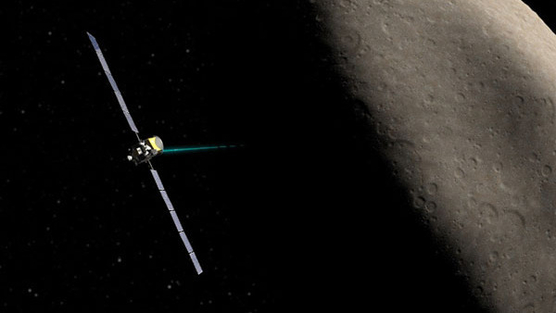
Probably many have heard of NASA's plans to capture the asteroid, drag it closer to the lunar orbit, and explore during a manned flight. They also have plans to try to move the asteroid from its orbit by hitting a metal blank. The study of asteroids from span trajectories by various NASA and ESA devices, even CNSA (China), has been repeatedly carried out. The Japanese managed not only to reach the asteroid, but also to capture its soil and return to Earth. Precious metals also probably heard about private traders who are going to dig on asteroids.
In this direction of space exploration, neither the USSR nor Russia has anything to boast about. Therefore the currentThe “crusade on asteroids” announced in the Russian media, after discovering the potentially dangerous near-Earth asteroid 2013 TV135, looks at least unfounded.
But, as it turned out, away from the high offices, Twitter and TV cameras of journalists, young scientists, engineers and programmers of the NGO named after S.A. Lavochkin, Space Research Institute RAS, Institute of Applied Mathematics. M.V. Keldysh has been engaged in the development of an automatic spacecraft for flight and the study of asteroids for two years.

The working name of the asteroid probe: MKA-ERDU "Anapa" - a small spacecraft with an electric rocket propulsion system. Its mass is supposed to be about 400 kg, and it should fly using a stationary plasma engine. In principle, the scheme of the device allows it to be sent even to the Moon, even to asteroids, but the Moon has been studied much better, and the topic of asteroids has been relevant for more than a year.
The main advantage of the device, and its difference from other Soviet and Russian interplanetary stations, is indicated in its name - an electric rocket propulsion system. Due to this, he can do without the use of the upper stage for output to the interplanetary trajectory. The propulsion system, the small mass of the probe and the dimensions make it possible to display it along the way, when launching any other device into geostationary orbit.
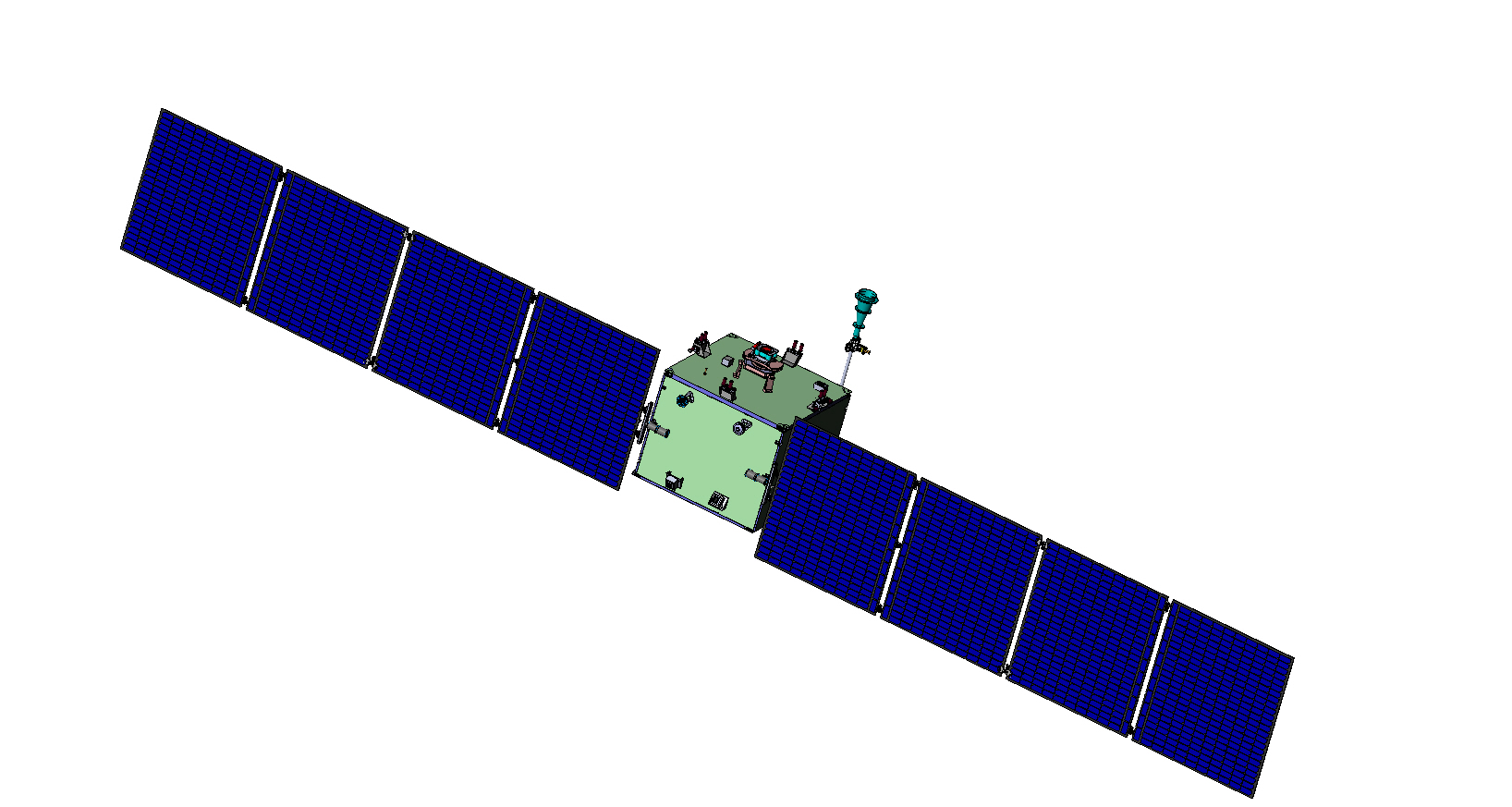
In order to leave the earth's orbit and go to the solar satellite, it will take a lot of time. In addition, for acceleration it will be necessary to perform at least one gravitational maneuver near the Earth.
True, the MKA-ERD will not reach the recently discovered 2013 TV135 asteroid 2013, declared by the domestic media to be the main threat to the Earth - a more powerful probe is needed there. Earlier, as part of a research project, scientists from the Space Research Institute of the Russian Academy of Sciences calculated the trajectory of “interplanetary billiards” when the device does not fly directly to the final goal of its route - Apophis asteroid,
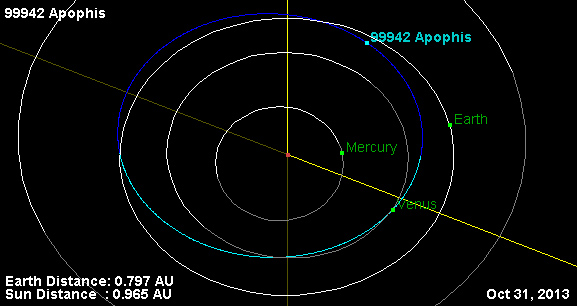
but approaches another 2011 UK asteroid 10 along the way.

This is one of the advantages provided by the electric rocket engine. The scientific program of the Dawn NASA spacecraft is developing in the same way: studied West and now flies to the dwarf planet Ceres.
The first oncoming asteroid can be studied along a flight path, as, for example, Rosetta did this with Steins asteroid:
Or NEAR with Matilda:
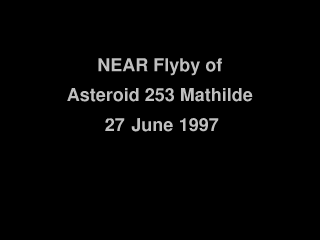
The ultimate goal of the expedition - Apophis, will create a very difficult task. Its size is about 400 m. The mass of such an asteroid is not enough to create a strong gravitational field, therefore, entering its orbit will require much more effort, time and mathematics than, for example, entering the orbit of the moon. It is possible that you will have to try several times. NASA did this, but there the target was the 30-kilometer asteroid Eros. You may have to do as JAXA did during the landing on the 300-meter asteroid Itokawa - the device just flew nearby.
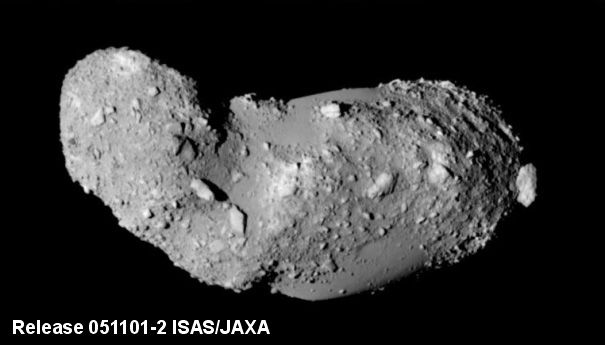
Domestic experience in the implementation of such operations relates only to the flight of Vega automatic interplanetary stations in 1986. But there, the rapprochement with Halley's comet was carried out on a collision course, and adjustments were carried out with the support of 22 astronomical institutions of the USSR. Now there are only a few of the scientific personnel of those times, so the "crew" of the MKA-ERD will have to study again.
Now more about the equipment that is supposed to be used at Anapa.
The basis of the spacecraft should be the Karat
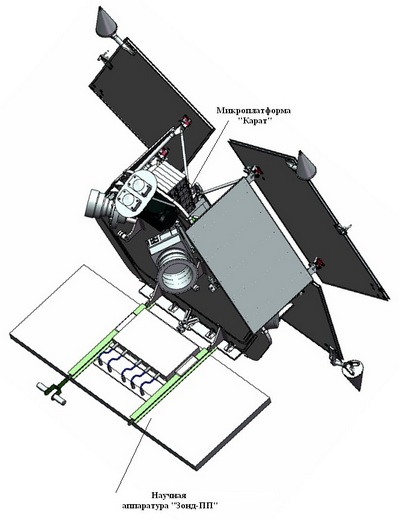
platform : the Platform will have to be substantially improved, since it is necessary to place equipment on it that requires a more powerful power supply system - primarily an electric rocket engine.
The type and model of the propulsion system was chosen from four options: the German ion exchanger RIT-10, two Kaliningrad plasma (Hall) SPD-70, SPD-100 manufactured by OKB Fakel and the plasma KM-60 Center named after Keldysh. Analysis of the mass-energy characteristics and engine life has led to the conclusion that the most appropriate is the use of SPD-100. An important factor was the engine resource of 9 thousand hours and its flight practice. (I believe that the RIT-10 was still losing for the price).
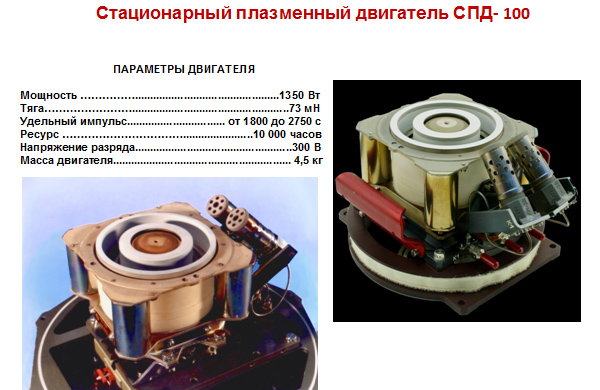
The satellite will be able to communicate using a narrow horn antenna, which should provide a transmission speed of up to 400 kb / s at a distance of the moon. The main scientific program will go much further, therefore, it is possible that in the far parts of the orbit communication will be interrupted altogether or carried out at the very minimum necessary to monitor the state of the device.
MKA-ERDU is able to take on board 16 kg of scientific equipment. The choice of devices was carried out with the participation of specialists from IKI RAS.
For visual research of space bodies and mapping, it is supposed to place a high-resolution camera with a shooting mode in the visible range on the device.
An infrared spectrometer is well suited to study surface composition.

For example, the OMEGA spectrometer Mars Express automatic interplanetary station .
Finally, a gamma spectrometer can be used to search for radioactive elements. They showed themselves well in the study of the moon and other satellites and planets, so it’s worth looking at asteroids. Suddenly there is something that will interest future space miners who are only looking at platinum and water on asteroids?
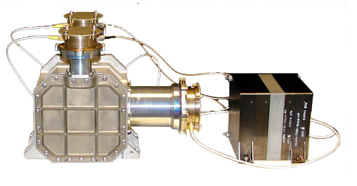
For example, the gamma spectrometer Messenger
In general, the Anapa MKA-ERDU is a simple and, at the same time, very promising apparatus. It is built, for the most part, from components tested in space according to a modular scheme. Of course, the launch and successful implementation of its scientific program does not promise to enrich world science with any fundamental knowledge. Unless, some absolutely unique asteroid is caught. The experience expected in this mission will be a repetition of what foreign space agencies have already done, but this is not a reason not to undertake its launch. Actually because it is necessary - it's time to catch up. It is especially important that young guys took up this program, who, subsequently, will be able to send more than one ship to interplanetary flights.
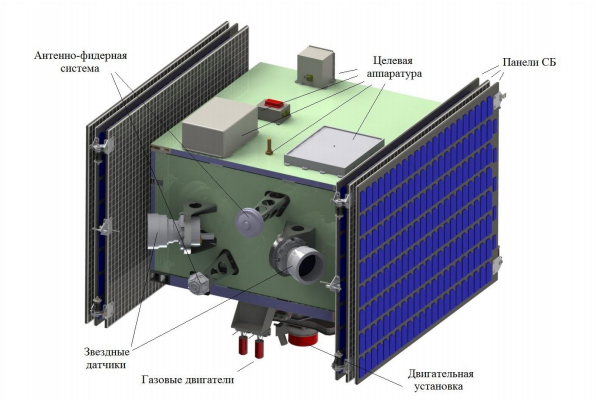
If we talk about the scientific and technical novelty of the proposed mission, then I would highlight a few points:
1) The MKA-ERD may become the first interplanetary vehicle of the Russian Federation to carry out a scientific program beyond the orbit of the moon;
2) The first for our country (USSR and RF), using an electric rocket marching propulsion system;
3) The first small spacecraft for our country weighing less than 500 kg, sent on an interplanetary flight outside the orbit of the moon;
4) The first for our country, implementing a scientific program for the study of asteroids at close range.
In addition, the implementation of this project will reduce the risks of all subsequent, and more fundamental studies, using an electric propulsion system, for example, an Interhelioprobe:
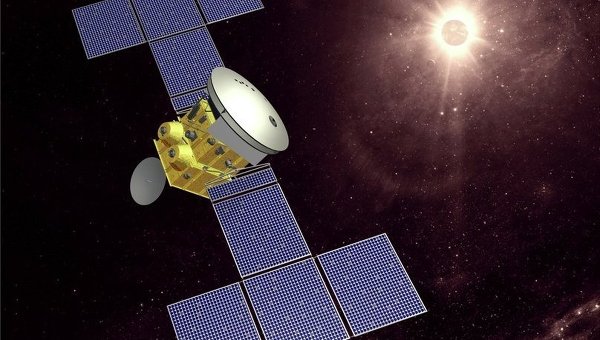
The launch of the MKA-ERDU is expected only by 2021. This slowness is explained by the fact that, in fact, all work is carried out as a hobby, i.e. after hours, almost pure enthusiasm. Now the initiative group has been allocated funding in the amount of 1 million rubles a year, but with this money the probe is not something that will not fly, but it simply cannot be collected.
So now the most important thing, for which I actually started talking about this idea: if we do not try, he will not fly anywhere. I don’t offer to take off, $ 70 million will not even be raised by Planetary Resouces. We can do something else.
Remember how we asked Roskosmossteer a little Electro-L? That was under the previous head of Roscosmos. How responsive this one is is not clear, but we can draw his attention to the MKA-ERDU project, since he himself spoke about the study of asteroids.
To do this, leave your signature . There you can log in via Facebook without registering. In the mobile version, to view the text of the letter, you must click "+" next to the "Overview".
The last time 1000 people were enough to awaken the soul in a seemingly ossified space-bureaucratic machine. I hope it will work out now. We do not require money, we ask you to consider the possibility of financing. Let the professionals decide whether to fly or not, we only pay attention to the project and express our interest.
Our signatures will not have any legal weight, but here the task is the same - to show that in Russia there are space enthusiasts who want our ships to plow not only near-Earth space, but also the entire solar system. Therefore, the more signatures there are, the better.
Go?
PS If someone has a desire to participate in the project in any way, regardless of whether they give money for it or not, contact sir_foxtrot is one of the developers.

Probably many have heard of NASA's plans to capture the asteroid, drag it closer to the lunar orbit, and explore during a manned flight. They also have plans to try to move the asteroid from its orbit by hitting a metal blank. The study of asteroids from span trajectories by various NASA and ESA devices, even CNSA (China), has been repeatedly carried out. The Japanese managed not only to reach the asteroid, but also to capture its soil and return to Earth. Precious metals also probably heard about private traders who are going to dig on asteroids.
In this direction of space exploration, neither the USSR nor Russia has anything to boast about. Therefore the currentThe “crusade on asteroids” announced in the Russian media, after discovering the potentially dangerous near-Earth asteroid 2013 TV135, looks at least unfounded.
But, as it turned out, away from the high offices, Twitter and TV cameras of journalists, young scientists, engineers and programmers of the NGO named after S.A. Lavochkin, Space Research Institute RAS, Institute of Applied Mathematics. M.V. Keldysh has been engaged in the development of an automatic spacecraft for flight and the study of asteroids for two years.

The working name of the asteroid probe: MKA-ERDU "Anapa" - a small spacecraft with an electric rocket propulsion system. Its mass is supposed to be about 400 kg, and it should fly using a stationary plasma engine. In principle, the scheme of the device allows it to be sent even to the Moon, even to asteroids, but the Moon has been studied much better, and the topic of asteroids has been relevant for more than a year.
The main advantage of the device, and its difference from other Soviet and Russian interplanetary stations, is indicated in its name - an electric rocket propulsion system. Due to this, he can do without the use of the upper stage for output to the interplanetary trajectory. The propulsion system, the small mass of the probe and the dimensions make it possible to display it along the way, when launching any other device into geostationary orbit.

In order to leave the earth's orbit and go to the solar satellite, it will take a lot of time. In addition, for acceleration it will be necessary to perform at least one gravitational maneuver near the Earth.
True, the MKA-ERD will not reach the recently discovered 2013 TV135 asteroid 2013, declared by the domestic media to be the main threat to the Earth - a more powerful probe is needed there. Earlier, as part of a research project, scientists from the Space Research Institute of the Russian Academy of Sciences calculated the trajectory of “interplanetary billiards” when the device does not fly directly to the final goal of its route - Apophis asteroid,

but approaches another 2011 UK asteroid 10 along the way.

This is one of the advantages provided by the electric rocket engine. The scientific program of the Dawn NASA spacecraft is developing in the same way: studied West and now flies to the dwarf planet Ceres.
The first oncoming asteroid can be studied along a flight path, as, for example, Rosetta did this with Steins asteroid:
Or NEAR with Matilda:

The ultimate goal of the expedition - Apophis, will create a very difficult task. Its size is about 400 m. The mass of such an asteroid is not enough to create a strong gravitational field, therefore, entering its orbit will require much more effort, time and mathematics than, for example, entering the orbit of the moon. It is possible that you will have to try several times. NASA did this, but there the target was the 30-kilometer asteroid Eros. You may have to do as JAXA did during the landing on the 300-meter asteroid Itokawa - the device just flew nearby.

Domestic experience in the implementation of such operations relates only to the flight of Vega automatic interplanetary stations in 1986. But there, the rapprochement with Halley's comet was carried out on a collision course, and adjustments were carried out with the support of 22 astronomical institutions of the USSR. Now there are only a few of the scientific personnel of those times, so the "crew" of the MKA-ERD will have to study again.
Now more about the equipment that is supposed to be used at Anapa.
The basis of the spacecraft should be the Karat

platform : the Platform will have to be substantially improved, since it is necessary to place equipment on it that requires a more powerful power supply system - primarily an electric rocket engine.
The type and model of the propulsion system was chosen from four options: the German ion exchanger RIT-10, two Kaliningrad plasma (Hall) SPD-70, SPD-100 manufactured by OKB Fakel and the plasma KM-60 Center named after Keldysh. Analysis of the mass-energy characteristics and engine life has led to the conclusion that the most appropriate is the use of SPD-100. An important factor was the engine resource of 9 thousand hours and its flight practice. (I believe that the RIT-10 was still losing for the price).

The satellite will be able to communicate using a narrow horn antenna, which should provide a transmission speed of up to 400 kb / s at a distance of the moon. The main scientific program will go much further, therefore, it is possible that in the far parts of the orbit communication will be interrupted altogether or carried out at the very minimum necessary to monitor the state of the device.
MKA-ERDU is able to take on board 16 kg of scientific equipment. The choice of devices was carried out with the participation of specialists from IKI RAS.
For visual research of space bodies and mapping, it is supposed to place a high-resolution camera with a shooting mode in the visible range on the device.
An infrared spectrometer is well suited to study surface composition.

For example, the OMEGA spectrometer Mars Express automatic interplanetary station .
Finally, a gamma spectrometer can be used to search for radioactive elements. They showed themselves well in the study of the moon and other satellites and planets, so it’s worth looking at asteroids. Suddenly there is something that will interest future space miners who are only looking at platinum and water on asteroids?

For example, the gamma spectrometer Messenger
In general, the Anapa MKA-ERDU is a simple and, at the same time, very promising apparatus. It is built, for the most part, from components tested in space according to a modular scheme. Of course, the launch and successful implementation of its scientific program does not promise to enrich world science with any fundamental knowledge. Unless, some absolutely unique asteroid is caught. The experience expected in this mission will be a repetition of what foreign space agencies have already done, but this is not a reason not to undertake its launch. Actually because it is necessary - it's time to catch up. It is especially important that young guys took up this program, who, subsequently, will be able to send more than one ship to interplanetary flights.

If we talk about the scientific and technical novelty of the proposed mission, then I would highlight a few points:
1) The MKA-ERD may become the first interplanetary vehicle of the Russian Federation to carry out a scientific program beyond the orbit of the moon;
2) The first for our country (USSR and RF), using an electric rocket marching propulsion system;
3) The first small spacecraft for our country weighing less than 500 kg, sent on an interplanetary flight outside the orbit of the moon;
4) The first for our country, implementing a scientific program for the study of asteroids at close range.
In addition, the implementation of this project will reduce the risks of all subsequent, and more fundamental studies, using an electric propulsion system, for example, an Interhelioprobe:

The launch of the MKA-ERDU is expected only by 2021. This slowness is explained by the fact that, in fact, all work is carried out as a hobby, i.e. after hours, almost pure enthusiasm. Now the initiative group has been allocated funding in the amount of 1 million rubles a year, but with this money the probe is not something that will not fly, but it simply cannot be collected.
So now the most important thing, for which I actually started talking about this idea: if we do not try, he will not fly anywhere. I don’t offer to take off, $ 70 million will not even be raised by Planetary Resouces. We can do something else.
Remember how we asked Roskosmossteer a little Electro-L? That was under the previous head of Roscosmos. How responsive this one is is not clear, but we can draw his attention to the MKA-ERDU project, since he himself spoke about the study of asteroids.
To do this, leave your signature . There you can log in via Facebook without registering. In the mobile version, to view the text of the letter, you must click "+" next to the "Overview".
The last time 1000 people were enough to awaken the soul in a seemingly ossified space-bureaucratic machine. I hope it will work out now. We do not require money, we ask you to consider the possibility of financing. Let the professionals decide whether to fly or not, we only pay attention to the project and express our interest.
Our signatures will not have any legal weight, but here the task is the same - to show that in Russia there are space enthusiasts who want our ships to plow not only near-Earth space, but also the entire solar system. Therefore, the more signatures there are, the better.
Go?
PS If someone has a desire to participate in the project in any way, regardless of whether they give money for it or not, contact sir_foxtrot is one of the developers.
